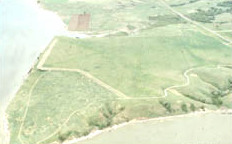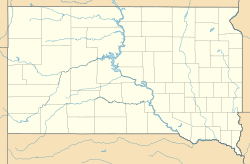Crow Creek massacre facts for kids
|
Crow Creek Site
|
|

Aerial view of the site
|
|
| Nearest city | Chamberlain, South Dakota |
|---|---|
| Built | circa 1100 CE |
| NRHP reference No. | 66000710 |
Quick facts for kids Significant dates |
|
| Added to NRHP | October 15, 1966 |
| Designated NHL | July 19, 1964 |
The Crow Creek massacre happened a long time ago, around the mid-1300s. It involved Native American groups living near the Missouri River in what is now South Dakota. Today, this important place is called the Crow Creek Site. It's an archaeological site and a special U.S. National Historic Landmark near Chamberlain, South Dakota. Scientists have studied parts of the site since the 1950s, with more digs in 1978 and later.
Two different groups lived at the Crow Creek site in ancient times. The first group, called the Middle Missouri people, spoke Siouan languages. They were ancestors of today's Mandan people. They built many earth lodges on the lower part of the site after about 900 AD.
Later, around 1150 AD, another group moved in. These were the Central Plains people, who spoke Caddoan languages. They came from areas further south, like present-day Nebraska. The Arikara people are descendants of this group. We don't know if they took over the site from the first group or if the site was empty when they arrived. The Central Plains people built at least 55 lodges, mostly on the upper part of the site. There is no clear proof that these two groups fought each other. In fact, experts have found signs that both cultures slowly changed over time, influenced by each other.
Contents
What Happened at Crow Creek?
The Central Plains villagers at Crow Creek built strong defenses for their village. They were replacing an older ditch with a new, bigger one around their expanded village. But during this time, an attack happened. The attackers killed all the villagers.
Archaeologists from the University of South Dakota found the remains of at least 486 people who died in this attack. Many of these remains showed signs of not having enough food. They also had evidence of injuries from earlier fights. This suggests that the Central Plains people were facing tough times. Experts believe they might have been attacked by other groups in the area. These groups could have been competing for good farming land and other important resources.
Discovering the Site
The Crow Creek site is officially known as 39BF11. It's located along the Missouri River in central South Dakota. Today, the land is managed by the United States Army Corps of Engineers. It's also surrounded by the Crow Creek Indian Reservation. The descendants of the ancient Middle Missouri and Central Plains people now live in North Dakota. They are part of the Three Affiliated Tribes.
Crow Creek is a very well-preserved archaeological site. It was named a National Historic Landmark in 1964.
In 1978, archaeologists found human bones sticking out of the ground at the site. This happened during a tour of the site, which had been known and partly dug up in the 1950s. After getting permission from the tribal council, archaeology teams carefully dug up the skeletal remains of at least 486 villagers. They figured out the number of people by counting certain bones. The way the remains were found shows they were killed in a huge attack, which is now called the Crow Creek Massacre. This discovery made archaeologists wonder who attacked the village and why.
Studying the Remains
The remains of the Crow Creek villagers were found in a defensive ditch. They were buried there in the mid-14th century and covered with a layer of clay. We don't know who buried the victims – it could have been the attackers, villagers who escaped, or people from a nearby village.
Studying these remains tells us a lot about the villagers' lives and their sudden deaths. They show signs of not getting enough nutrients and also evidence of previous battles. This suggests that adapting to changes was very hard for them. A scientist named John B. Gregg studied these signs of health and disease in ancient bones.
Why Crow Creek Matters Today
The discovery at Crow Creek and the need to respect ancient human remains led to important discussions. In 1989, a big meeting called the World Archaeological Congress took place. Archaeologists and Indigenous people from many countries talked about what to do with ancient human remains. They created an agreement called the Vermillion Accord.
This agreement helped create new laws in places like Canada and the United States. It also influenced rules for archaeologists around the world. For example, the Native American Graves Protection and Repatriation Act (NAGPRA) was passed in the U.S. in 1990. This law helps make sure that Native American human remains and important cultural items are returned to their tribes. It also requires archaeologists to talk with tribes before digging up sites.



